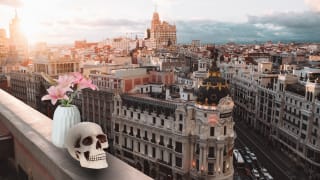The politics of space, culture, and placemaking for post-COVID place branding
The coronavirus lockdown has been full of revelations that may shape a new future for both rural places and the world’s cities. People are re-evaluating the importance of community - and what made a place attractive before may not be relevant now. Estate agents in the UK are reporting an avalanche of enquiries for more rural locations now that working from home is more acceptable and the need to be “commutable” is less valued, and we’re sure this is not a situation unique to Britain. The difficulties for our cities’ cultural attractions are far from over as many struggle to see a way to re-open in ways that fit with social distancing regulations. Easy access to public space has been the saving grace for many during this challenging time; and we are not really all in this together in the same way.
This won’t be the first pandemic to create long lasting changes in the design of public spaces. In 14th century Europe, the Bubonic Plague was the catalyst for a number of urban changes, including opening larger public spaces and redesigning to more away from cramped living quarters. Some five hundred years later, Victorian reformer William Farr noted that “a park in the East End of London would probably diminish the annual deaths by several thousand … and add several years to the lives of the entire population”.
Just as tourism teams are looking to “reset” with a more sustainable approach, place leaders and economic development teams are reconsidering approaches to placemaking. There is a need to reinvent our public spaces to rebuild the attractiveness of places – and to reconnect communities that have been living in isolation for upwards of three months.
Culture and community
Recently, we’ve seen more organisations innovating and creating safe experiences for a post-COVID-19 world. The touring production of ‘The Phantom of the Opera’ in Seoul plays to a nearly full house each night thanks to a comprehensive tracking system and temperature sensors at the doors of the theatre. Other organisations are enforcing timed ticket slots and reduced numbers, such as the Rijksmuseum in Amsterdam.
We’re written before about the number of DMOs and EDOs who have pivoted to support their SMEs and cultural institutions and continuing to support these organisations who are innovating and evolving will help to preserve the heart and soul of our communities. But there’s more that needs to be done. According to Julian Tang, a virologist from England’s University of Leicester, “the likelihood of a successful infection occurring from an exposure outside is likely less because the sunlight may damage the virus as it passes through the air between people.” With social distancing easier to manage in an open space, and the risks of catching the virus diminished, public space could hold the key to opening up quickly and safely.
But how do we move indoor business outdoors?
Vilnius, capital of Lithuania, will be re-allocating much of their public space to struggling bar and restaurant owners – effectively turning the city into an open-air café. With eighteen of the city’s public spaces given over to the project, businesses will be able to resume business while still observing physical distancing rules. So far, more than 160 businesses have applied to be a part of the initiative.
We need to reinvent what our public spaces can do. Outdoor theatre and cinema need to move into the mainstream. Art exhibitions can be bought on to the streets. Disused public space can be reclaimed as pocket parks to help bring green spaces into densely urban areas. These changes will be pivotal to renewing the quality of life proposition that people are seeking.
Sustainable city infrastructure
There’s been a global explosion in cycling, with cities around the world transforming empty road lanes into cycle paths. Theoretically, most of these changes are temporary – they’re a short-term fix to the anxieties about public transport during a pandemic. But many councils are keen to make these changes more permanent. Walkability is of growing importance for people looking to relocate, and safer cycling spaces are a green alternative to driving, decreasing the strain on overtaxed public transport.
The Mayor of Athens, Kostas Bakoyannis, is one of several city leaders who has ambitious plans for urban rejuvenation – with plans to allocate 50,000 square metre of public space for cyclists and pedestrians: “We have this once-in-a-lifetime opportunity and are fast-forwarding all our public works[.] The goal is to liberate public space from cars and give it to people who want to walk and enjoy the city.” Meanwhile in Berlin, a city which has been known to take 10 years to build a bike lane opened up 14 miles in between three and ten days. These aren’t isolated phenomena either. New York. Bogota. Paris. Sydney. London. Cities around the world are reimagining how public space can be better used for residents.
We’re teetering on the edge of a sustainable transport revolution, but we need to be thoughtful in how we proceed. Traditionally, space is a luxury afforded to the wealthy. While improving our public spaces will be key to recovery, we need to ensure that we develop equally and don’t price out the local communities as these innovations make certain areas more desirable.
Politics of space
“The pandemic has exposed the gulf between the space-poor and the space-rich to create a new politics of resentment, a coarsening of discourse,” Roger Boyes, Diplomatic Editor for the Times argues. Space has become a closely guarded commodity. Suddenly a private balcony is a godsend, and a garden? Luxury. The lockdown experience has been vastly different for those who have personal gardens, those who have easy access to public communal space, and those who are left without.
It’s also important to note that for all the vilification of urban density as a prime breeding ground for COVID-19, it isn’t the cause of pandemic. Or at least, not alone. In New York for example, the population dense (but economically wealthy) Manhattan is one of the least affected boroughs. Contrastingly, Queens & the Bronx (moderately dense but less well-off) have been some of the hardest hit. Phil Myrick at the Project for Public Spaces refers to the pattern as a “‘doughnut,’ with the downtown and gentrified inner neighbourhoods largely spared, and a crisis unfolding in distressed outer neighbourhoods.”
It would be reductive to say that this is purely due to access to public space. Lower income groups are more likely to be key workers out on the front line, with less ability to work remotely. But less access to public space also means that more people are being crowded into smaller locations. And those who have the additional struggle of living in food deserts need to travel further for their basic necessities – opening them up to greater risk.
Placemaker and author Jay Pitter has coined two terms. First, the dominant density – “designed by and for predominately white, middle-class urban dwellers living in high-priced condominiums within or adjacent to the city’s downtown core.” And then the forgotten densities: mobile park homes; favelas; tent cities; public housing; shanty towns.
There is a risk that by building better public spaces, by changing policy to support outdoor business ventures, you can price out the very people that you’re trying to support. We need to ensure equitable development to enable us to protect our forgotten densities from the next crisis. Moral and ethical reasons for helping people achieve their basic needs aside, it’s a weak spot in our pandemic defence.
The Superillas of Barcelona
So how do you add public space to an area without gentrifying it? Some of the answer is policy and zoning to ensure people can continue to live in your city affordably. Perhaps though, Barcelona’s superblocks could be a model for the future.
Take the Poblenou superblock. By restricting traffic to a set of one-way systems and a 10km/hr speed limit, the superblock encourages through-traffic to move elsewhere. And by decreasing the cars on the roads to residential traffic, they were able to convert the unused lanes into community spaces – outside seating, play parks, and cafes. Cars have become an afterthought to community life.
Crucially though, the Poblenou superblock is surrounded by a social housing project – protecting residents from rising house costs.
With fifteen more superblocks in progress and plans to build over 500 in the coming decades, the model has evolved to put the residents at the heart of the planning process. “There won’t be any surprises,” says Janet Sanz, Barcelona’s deputy mayor for ecology, urbanism, and mobility. “[The residents] will feel like it’s theirs from the first moment, because they co-designed it alongside City Hall.”
Preparing for the new normal 2.0
We weren’t prepared for any of this - but we can prepare for what comes next. In the face of a recession, it’s easy to ask if time and money should be spent on reinventing our public spaces, but we could, we should and frankly, we have to. The pandemic has highlighted how inadequate access to open space is for many city dwellers, and how much this is disadvantaging already underprivileged groups. Being more creative in our reimaging of public space will be key to short-term recovery and will also drive longer-term place attractiveness by ensuring the health and resilience of our communities and by improving the quality of life for all residents.
This is too important an opportunity to be left solely with urban planning experts. City marketing boards, DMOs, EDOs, BID teams, and chambers of commerce who understand the circular connection between places that are great to live in, to work in, to visit, and to invest in can all play a pivotal role. There’s never been a better time to work together on a place brand and development strategy that engages the community, re-imagines a better future, and advocates for equitable development – to ensure that no one is left behind again.
Related reading
The politics of space, culture, and placemaking on post-COVID place branding









